
 |
Tea Clipper |
 |
| from TeaAntiques.com | ||
| Edition Twenty Four |
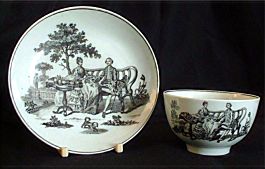 The antique
of the month for October, is a most charming Worcester Tea Bowl and Saucer
dating from c1780. This very pretty item is decorated in on-glaze black (or jet-enamel as it was then called), with a print known as the 'Tea Party'. This
delightful scene epitomises the English gentry taking tea in the eighteenth
century. Not only is it a charming scene, it now provides an insight into social
history and the tea taking ceremony.
The antique
of the month for October, is a most charming Worcester Tea Bowl and Saucer
dating from c1780. This very pretty item is decorated in on-glaze black (or jet-enamel as it was then called), with a print known as the 'Tea Party'. This
delightful scene epitomises the English gentry taking tea in the eighteenth
century. Not only is it a charming scene, it now provides an insight into social
history and the tea taking ceremony.
An extremely fine example of an early Worcester 'transfer printed' Tea Bowl and Saucer and can be viewed in more detail on the TeaAntiques web site.
More details of this item and other tea related antiques can be found by visiting my web site at www.TeaAntiques.com.
Here in England, many of the stately homes will shortly be closing their doors to visitors, the winter season is approaching fast and many of the National Trust houses are being put to bed. Therefore, I thought that I would like to end the opening season with a favourite house of mine and one where there are some very interesting items for the lover of Tea related antiques and the taking of tea in the eighteenth century.
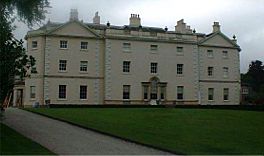
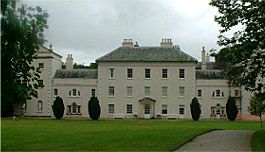 Indeed,
Saltram house is a delight from the mid-Georgian period, with some stunning work
by Robert Adam. Having said that, the house is actually built around an earlier
house from the Tudor and Stuart periods. The white stucco house that we see
today is largely the result of its remodelling in the mid eighteenth century by
John Parker.
Indeed,
Saltram house is a delight from the mid-Georgian period, with some stunning work
by Robert Adam. Having said that, the house is actually built around an earlier
house from the Tudor and Stuart periods. The white stucco house that we see
today is largely the result of its remodelling in the mid eighteenth century by
John Parker.
The Parker family acquired the house in 1712, bought by George Parker of Boringdon, later to become the Earls of Morely. What is quite amazing is that it remained in the Parker family until it was taken over by the National Trust in 1957.
John Parker, who was created Lord Boringdon in 1784, wanted to improve the house and engaged Robert Adam to carry out some stunning changes to the interiors. These alterations took place c1768. The two most famous Adam rooms at Saltram being the magnificent Saloon and Dining Room. These rooms also contain the original Adam furnishings and are absolutely breathtaking to see.
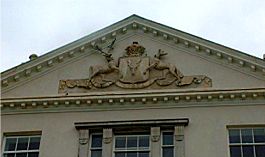 Before taking you inside, I should explain a little about the exterior of this
lovely house. The South front of the house is of three storeys, to the sides of
the main central block are two projecting bays which travel the height of the
building. The central block has a later porch with its Doric columns added in
the early nineteenth century. At the top of the central block is a triangular
pediment in which can be seen the arms of of the 1st Earl of Morely.
Before taking you inside, I should explain a little about the exterior of this
lovely house. The South front of the house is of three storeys, to the sides of
the main central block are two projecting bays which travel the height of the
building. The central block has a later porch with its Doric columns added in
the early nineteenth century. At the top of the central block is a triangular
pediment in which can be seen the arms of of the 1st Earl of Morely.
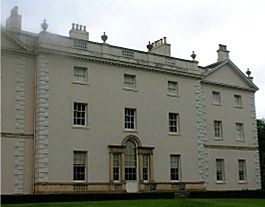 The
East front of the house shows the main central block with pedimented wings
either side. A feature to note is the beautiful Venetian window in the central
position of the ground floor. This delightful large window was added by Robert
Adam and forms the central window of his Saloon.
The
East front of the house shows the main central block with pedimented wings
either side. A feature to note is the beautiful Venetian window in the central
position of the ground floor. This delightful large window was added by Robert
Adam and forms the central window of his Saloon.
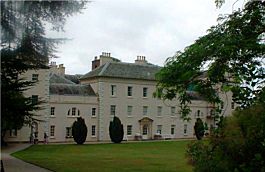
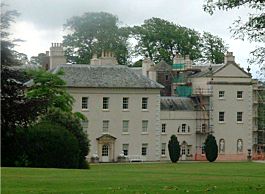 At
the West front of the house, one sees the earlier central block, five bays with
a hipped roof, this part built at the end of the seventeenth century. There are
two tall wings at either side with pedimented tops, joined to the central block
by lower connecting wings. These were added onto the house by John Parker in
1740. This front of the house shows as mixture of levels, types of window style
and some niches in which are housed some Classical statues. These statues are
made of lead and represent Mercury, Isis, a Vestal Virgin and Antinous.
At
the West front of the house, one sees the earlier central block, five bays with
a hipped roof, this part built at the end of the seventeenth century. There are
two tall wings at either side with pedimented tops, joined to the central block
by lower connecting wings. These were added onto the house by John Parker in
1740. This front of the house shows as mixture of levels, types of window style
and some niches in which are housed some Classical statues. These statues are
made of lead and represent Mercury, Isis, a Vestal Virgin and Antinous.
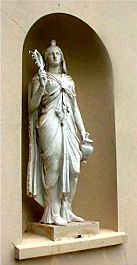
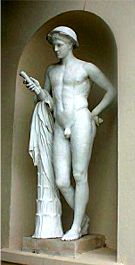
The visitor enters the house through the main entrance on the South front which leads into the Entrance Hall. This is a very beautiful Hall, that has some very grand plasterwork on the walls and ceiling, all mid eighteenth century in taste and style.
One feature that caught my eye was a large stone fireplace, with caryatid columns, the mantle formed by a broken pediment in which sits a large bust. There is a central carved panel in the fireplace which depicts ‘Androcles and the Lion’. There is a similar fireplace to this one at Uppark House in West Sussex. The one here at Saltram, like Uppark, was made by Thomas Carter the elder.
The Hall has a chequered stone floor on which stand a set of eighteenth century hall chairs. These chairs have wooden seats and have open fret backs and arms in the style of Chinese Chippendale. On the wall is mounted a very grand eighteenth century French Boulle bracket clock dating from about 1740.
To the right of the Hall is the Morning Room, lined with dark red velvet walls which are hung around with a three tier set of oil paintings. There are many interesting oil paintings including members of the Parker family. Sir Joshua Reynolds was a life long friend of Lord Boringdon, so needless to say there are quite a number of paintings by him in the house and in this room. This room was used by the family in which to take breakfast, or to dine in on occasions when there were no guests in the house. There is a ‘D’ ended mahogany table in the centre of the room around which are a fine set of dining chairs - the backs carved in a ‘Gothick’ taste and date from the1760’s.
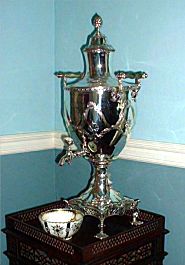
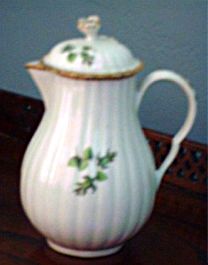 From
the Morning Room the visitor passes into the Velvet Drawing room, a pretty room
which takes in one of the bay windows of the South Front. There is some
elaborate plasterwork to the ceiling and frieze, a large white marble fireplace
above which is a handsome Chippendale style gilt framed mirror. In the window
bay is a Pembroke Table on which sit some interesting tea equipage from the
eighteenth century. Laid out for tea there is a delightful Georgian silver Tea
Urn with ball feet, handles fashioned in the form of serpents, a ‘Greek key’
pattern around the base and moulded foliage running up over the body of the Urn-
a magnificent piece (The one illustrated here is similar in date and style).
Accompanying the Tea Urn is a part Worcester Tea service, this charming set has
painted floral scenes inside a turquoise ground colour. Included on the table
are a tea poy, teapot, covered milk jug (similar to that illustrated, which are
taken from my own collection) and
several cups and saucers. As a lover of tea antiques this little set up was a
joy to see.
From
the Morning Room the visitor passes into the Velvet Drawing room, a pretty room
which takes in one of the bay windows of the South Front. There is some
elaborate plasterwork to the ceiling and frieze, a large white marble fireplace
above which is a handsome Chippendale style gilt framed mirror. In the window
bay is a Pembroke Table on which sit some interesting tea equipage from the
eighteenth century. Laid out for tea there is a delightful Georgian silver Tea
Urn with ball feet, handles fashioned in the form of serpents, a ‘Greek key’
pattern around the base and moulded foliage running up over the body of the Urn-
a magnificent piece (The one illustrated here is similar in date and style).
Accompanying the Tea Urn is a part Worcester Tea service, this charming set has
painted floral scenes inside a turquoise ground colour. Included on the table
are a tea poy, teapot, covered milk jug (similar to that illustrated, which are
taken from my own collection) and
several cups and saucers. As a lover of tea antiques this little set up was a
joy to see.
The transition between the Morning room andthe next – the Saloon is quite amazing. This breath taking room was the work of Robert Adam and dates from c1770. A palatial room designed for grand entertaining, it is of a double cube, exquisitely decorated in the typical Adam style. The walls are hung with very pretty light blue damask, also used as furniture covering material creating a united appearance. The ceiling is covered with stunning Neo Classical plasterwork and contains finely painted panels, these the work of Antonio Zucchi. The furniture is equally magnificent, there is a very grand suite of gilt wood furniture, including settees and open arm chairs, these are the work of none other than Thomas Chippendale. Adam designed the room, including the fixtures such as the large and stately wall mirrors. The designs on the ceiling are reflected in the pattern woven into the carpet, this was made at the famous Axminster factory in 1770, designed specifically for the room. This is certainly a very fine and gracious room to behold, especially with the pair of brilliantly sparkling chandeliers. These chandeliers seem to defy the strength of the ceiling to hold them up! These are not part of the original Adam design, but introduced into the room in the nineteenth century, they certainly do not look out of place here.
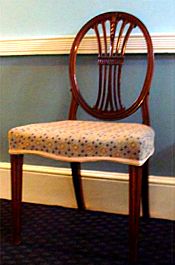
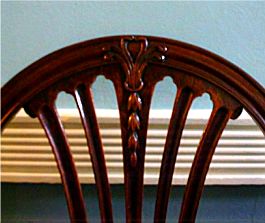 The
Dining room is another of Robert Adams grand entertaining rooms. The walls and
ceiling embellished with fine plaster work, the walls a soft green in colour. In
the centre of the room is a large white damask covered table round which are a
handsome set of dining chairs in the Hepplewhite style dating form c1780
(similar to the chair illustrated, which is taken from my own collection). Upon the table is a dinner service, painted
in delicate green floral designs and carry the family crest of the Parkers.
The
Dining room is another of Robert Adams grand entertaining rooms. The walls and
ceiling embellished with fine plaster work, the walls a soft green in colour. In
the centre of the room is a large white damask covered table round which are a
handsome set of dining chairs in the Hepplewhite style dating form c1780
(similar to the chair illustrated, which is taken from my own collection). Upon the table is a dinner service, painted
in delicate green floral designs and carry the family crest of the Parkers.
For the lover of Tea and its interesting history, there is a real treat to be found upstairs in the house in one of the bedrooms!
The Chinese Chippendale bedroom is absolutely amazing, furnished with a stately mahogany Chippendale four poster bed c1760. This room demonstrates the strong influence on the oriental and particularly the Chinese designs at this period. The room is hung round with Chinese hand painted wallpaper. In fact this wall paper from the eighteenth century, came from another room in the house, it had been taken down when the original room in which it was housed was found to be suffering from dry rot. The paper had been stored in a man servant's bedroom in the 1930's. Then in the 1960’s it was discovered by the National Trust and re-hung in this room, in which it just so happened to fit perfectly. It is this wall paper that is of interest to any body keen on the history of tea and tea drinking. The paintings on the paper are not of the usual Chinese birds and flowers, but instead show scenes from the tea industry. This is very rare and provides us with a glimpse into the past. Here there are charming scenes showing such activities as tea picking in the hills, tea drying, selecting and tasting as well as people sat enjoying tea on the balconies of their houses. I was absolutely entranced by discovering this wallpaper and the story that it was depicting. This has to be a shrine to the tea historian!
The tea theme treats are not yet over in this marvellous house, as in the Mirror Room downstairs is a collection of fine porcelain including tea wares. Displayed in cabinets, this collection includes A Worcester tea and coffee service. This set is decorated with enamelled buildings, ruins and figures in green and black with additional gilding. The tea cups and saucers interestingly have ‘crossed sword’ marks in imitation of Meissen. This set dates from c1770, painted by the reputable James Giles in his London Studio – a delightful service.
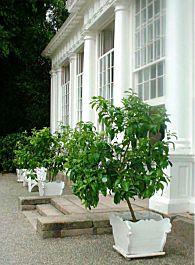
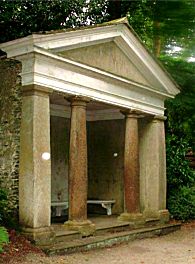 Having
completed the tour of the house there is a beautiful landscape garden in which
to walk. Here you can set upon discoveries such as the Orangery, temples
including ‘the Castle’, ‘Fanny’s Bower’ also the Fernery and
delightful walks.
Having
completed the tour of the house there is a beautiful landscape garden in which
to walk. Here you can set upon discoveries such as the Orangery, temples
including ‘the Castle’, ‘Fanny’s Bower’ also the Fernery and
delightful walks.
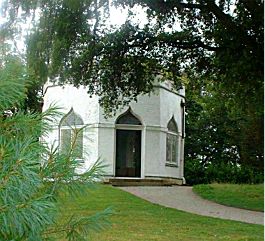
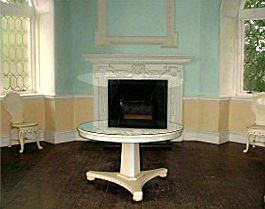 The
Castle temple is rather grand inside, from what appears to be a rather bland
exterior. There are some decorative plasterwork to the walls and the ceiling has
a deep moulded frieze. A fireplace has a white marble surround, carved with
relief including a classical head. There are some basic items of furniture in
this folly, including hall type chairs and central table - mirrored top to
reflect the ceiling plasterwork.
The
Castle temple is rather grand inside, from what appears to be a rather bland
exterior. There are some decorative plasterwork to the walls and the ceiling has
a deep moulded frieze. A fireplace has a white marble surround, carved with
relief including a classical head. There are some basic items of furniture in
this folly, including hall type chairs and central table - mirrored top to
reflect the ceiling plasterwork.
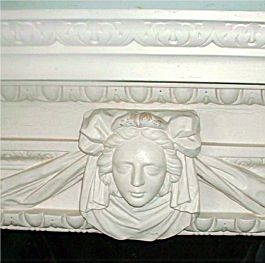
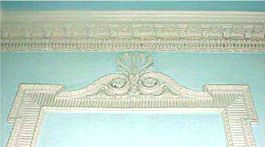
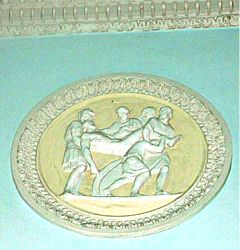
In the Stable block, set away from the house, there is now a shop and restaurant. Here, I rounded off the visit by partaking of tea and a welcome filled baguette, before wending my way home. A very pleasant visit to a magnificent and stately country house. One strongly recommended to visit.
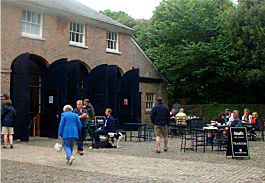
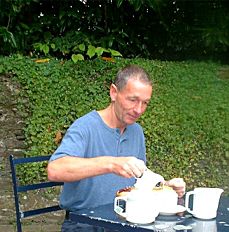
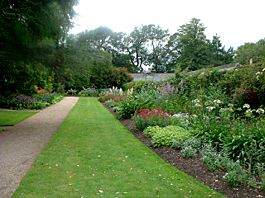
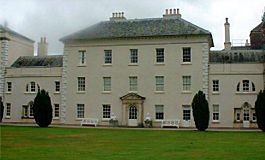 Saltram
House
Saltram
House
Plympton
Plymouth
PL7 1UH
Tel: 01752 333500
Fax: 01752 336474
Click here for
Local Map
Map courtesy of www.streetmap.co.uk
So important was the social act of taking tea in the eighteenth century, that we are fortunate to have been left some vivid images of this ceremony in various form. As could be seen at Saltram house, tea was considered important enough to show the tea gathering and processing on hand painted Chinese wall paper used to decorate an eighteenth century room. This wall paper would have been very expensive to procure and would undoubtedly been a subject of conversation amongst their guests who would have been greatly impressed by it.
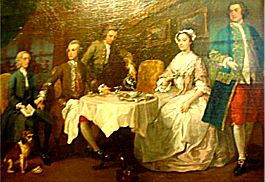
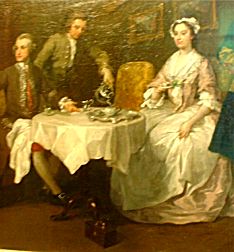 The
tea taking image was one of show, decadence and the symbol of importance. Tea
was expensive, only the rich could afford it and so it was considered very grand
to be painted taking tea. There are some delightful paintings from the
eighteenth century, which clearly depict the tea taking ceremony. In this
particular painting, a very wealthy English family are gathered for tea, which
has been laid out on a mahogany tripod tea table which has been covered with a
white damask table cloth. Wishing to impress and show their social standing the
table is set with their finest tea silverware, including a circular teapot,
sparrow beak milk jug with tree feet and a handsome silver waiter tray. A man
servant can be seen filling the teapot with hot water and the lady of the house
proudly sits up right with a tea bowl and saucer, of the finest porcelain, in
her right hand. Also notice, that there is a fine mahogany tea caddy positioned
on the floor just in front of the table. It is clear that the family wanted to
display all that they could to show them at a civilised afternoon tea.
The
tea taking image was one of show, decadence and the symbol of importance. Tea
was expensive, only the rich could afford it and so it was considered very grand
to be painted taking tea. There are some delightful paintings from the
eighteenth century, which clearly depict the tea taking ceremony. In this
particular painting, a very wealthy English family are gathered for tea, which
has been laid out on a mahogany tripod tea table which has been covered with a
white damask table cloth. Wishing to impress and show their social standing the
table is set with their finest tea silverware, including a circular teapot,
sparrow beak milk jug with tree feet and a handsome silver waiter tray. A man
servant can be seen filling the teapot with hot water and the lady of the house
proudly sits up right with a tea bowl and saucer, of the finest porcelain, in
her right hand. Also notice, that there is a fine mahogany tea caddy positioned
on the floor just in front of the table. It is clear that the family wanted to
display all that they could to show them at a civilised afternoon tea.
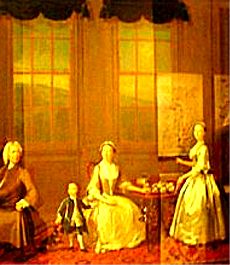
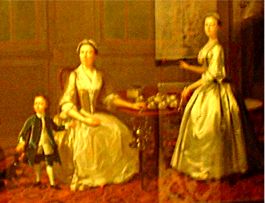 Similarly
in this painting, two important looking ladies are about to take tea along with
a young son and his pet dog. Again, they are showing off their tea equipage to
the full. Not only is their tripod table laid with tea china and a tea caddy,
but in front of this table stands a mahogany tripod kettle stand. On this pretty
little table stands the silver spirit kettle, from which hot water is taken to
make the exotic brew of tea.
Similarly
in this painting, two important looking ladies are about to take tea along with
a young son and his pet dog. Again, they are showing off their tea equipage to
the full. Not only is their tripod table laid with tea china and a tea caddy,
but in front of this table stands a mahogany tripod kettle stand. On this pretty
little table stands the silver spirit kettle, from which hot water is taken to
make the exotic brew of tea.
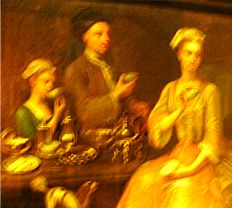 An
earlier painting ( for which I apologise about my picture quality), not only
does it show the various items of essential tea equipage, it also shows the
three members of the family actually proudly holding their precious tea bowls
ready to enjoy the tea. It is interesting to see three ways in which the tea
bowl is held. The lady on the right carefully holds it with her thumb supporting
it from under the foot, her forefinger holding it tightly by the rim of the
bowl. This is a functional way to hold what would have been quite a hot bowl!
The gentleman in the centre appears a little more relaxed and casual in the way
in which he holds his tea bowl, supporting it in his fingers and thumb. The
young girl on the left, who is sipping the tea from her tea bowl, supports it by
balancing it carefully with the tips of her fingers around its foot rim. On
their tea table are the important pieces of tea silverware, including teapot,
tea caddy. Also interestingly there also sits a china plate in which are thin
slices of bread and butter. At this early tea drinking period there were no
fancy sandwiches and cream cakes, only thin slices of bread and butter and maybe
a plain cake of some description. It was not until much later that the full
afternoon tea as we know it came into being.
An
earlier painting ( for which I apologise about my picture quality), not only
does it show the various items of essential tea equipage, it also shows the
three members of the family actually proudly holding their precious tea bowls
ready to enjoy the tea. It is interesting to see three ways in which the tea
bowl is held. The lady on the right carefully holds it with her thumb supporting
it from under the foot, her forefinger holding it tightly by the rim of the
bowl. This is a functional way to hold what would have been quite a hot bowl!
The gentleman in the centre appears a little more relaxed and casual in the way
in which he holds his tea bowl, supporting it in his fingers and thumb. The
young girl on the left, who is sipping the tea from her tea bowl, supports it by
balancing it carefully with the tips of her fingers around its foot rim. On
their tea table are the important pieces of tea silverware, including teapot,
tea caddy. Also interestingly there also sits a china plate in which are thin
slices of bread and butter. At this early tea drinking period there were no
fancy sandwiches and cream cakes, only thin slices of bread and butter and maybe
a plain cake of some description. It was not until much later that the full
afternoon tea as we know it came into being.
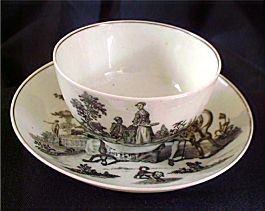
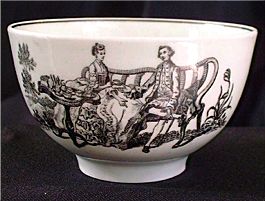 Having
seen the actual act of taking tea as depicted in oil paintings, there were other
ways in which the importance and romantic notions of tea drinking were shown off
to their full. Here is an early Worcester tea bowl (currently for sale on my web
site), which is beautifully decorated with a black transfer print of a romantic
afternoon tea in the garden of a great house. Here the grand lady and her
gentleman companion sit together on a garden bench, dressed in all their finery.
They have a wonderful galleried tripod table before them, laid with the tea
equipage. A fine shaped Tea Caddy, oval china tea poy, china teapot, silver hot
water or chocolate pot, tea bowls and saucers and sugar or slops basin ( hard to
tell which!). The lady is handing the gentleman a tea bowl and saucer and note
that there is a tea spoon placed on the saucer. A further scene on this tea bowl
shows a young servant carrying out a hot water kettle in order to make the tea.
Such items provide us now with a good and useful record of the way in which tea
was taken and perceived by English society in the middle of the eighteenth century. It is amazing to think that the
taking of tea is still a pleasure that many people enjoy, if even in a somewhat
more relaxed version.
Having
seen the actual act of taking tea as depicted in oil paintings, there were other
ways in which the importance and romantic notions of tea drinking were shown off
to their full. Here is an early Worcester tea bowl (currently for sale on my web
site), which is beautifully decorated with a black transfer print of a romantic
afternoon tea in the garden of a great house. Here the grand lady and her
gentleman companion sit together on a garden bench, dressed in all their finery.
They have a wonderful galleried tripod table before them, laid with the tea
equipage. A fine shaped Tea Caddy, oval china tea poy, china teapot, silver hot
water or chocolate pot, tea bowls and saucers and sugar or slops basin ( hard to
tell which!). The lady is handing the gentleman a tea bowl and saucer and note
that there is a tea spoon placed on the saucer. A further scene on this tea bowl
shows a young servant carrying out a hot water kettle in order to make the tea.
Such items provide us now with a good and useful record of the way in which tea
was taken and perceived by English society in the middle of the eighteenth century. It is amazing to think that the
taking of tea is still a pleasure that many people enjoy, if even in a somewhat
more relaxed version.
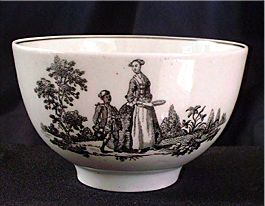
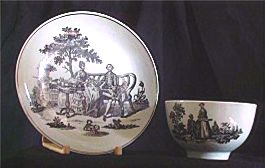
To review past newsletters, just follow this link:
Past newsletters.
To subscribe to this free newsletter -
Click here